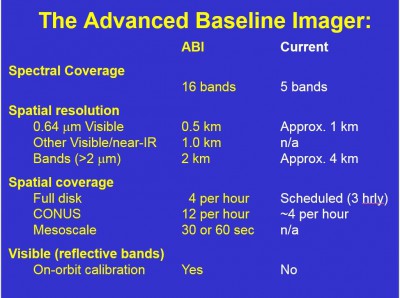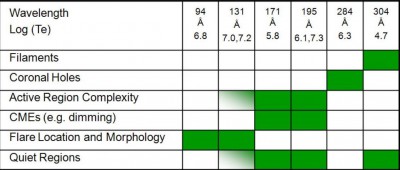The GOES-R Series Data Book provides detailed information on GOES-R Series instrument performance.
Instrument performance information currently available includes:
Advanced Baseline Imager (ABI):

Technical Summary of ABI Bands
ABI Spectral Response Functions
A Closer Look at the ABI on the GOES-R Series (Bulletin of the American Meteorological Society):
The GOES-R Program encountered a performance issue with the cooling system of the GOES-17 Advanced Baseline Imager (ABI) instrument during post-launch checkout in 2018. The loop heat pipe (LHP) subsystem, which transfers heat from the ABI electronics to the radiator, is not operating at its designed capacity. This is preventing adequate cooling for some of the infrared (IR) channels on the instrument. The effect is worse during warm portions of orbit, near midnight when sun enters the ABI aperture, and during warm seasons around vernal and autumnal equinoxes. Under worst case conditions, local emission and dark current noise cause the longer wavelength channels saturate and become unusable for some hours.
Optimization techniques have been successful in recovering more than 97% of planned ABI data. GOES-17 is currently observing with more channels, at a higher resolution, and with more rapid refresh than what is available from the current GOES West satellite. NOAA is confident the GOES constellation will continue to meet the operational needs of the National Weather Service and forecasters across the nation. See the GOES-17 ABI Performance webpage for additional information.
Geostationary Lightning Mapper (GLM):
- Staring CCD imager (1372×1300 pixels)
- Near-uniform spatial resolution of approximately 10 km
- Coverage up to 52 deg N lat
- 70-90% flash detection day and night
- Single band 777.4 nm
- 2 ms frame rate
- 7.7 Mbps downlink data rate (for comparison- TRMM LIS 8 kbps)
- < 20 sec product latency
Extreme Ultraviolet and X-ray Irradiance Sensors (EXIS):
EXIS Metrics:
| Mass | 30.0 kg |
| Power | 40 watts |
| X-Band Data Rate | 7.2 Kbps |
| L-Band Data Rate | 0.9 Kbps |
| Envelope | 76 x 30 x 37 cm |
| Thermal | Active Control, 2 Zones |
Space Environment In-Situ Suite (SEISS):
Energetic Heavy Ion Sensor (EHIS) Performance Requirements
Magnetospheric Particle Sensor – Low (MPS-LO) Performance Requirements
Magnetospheric Particle Sensor – High (MPS-HI) Performance Requirements
Solar and Galactic Proton Sensor (SGPS) Performance Requirements
Solar Ultraviolet Imager (SUVI):
SUVI Operational Goals:
- Locate coronal holes for geometric storm forecasts
- Detect and locate flares for forecasts of solar energetic particle events related to flares
- Monitor changes in the corona that indicate Coronal Mass Ejections (CMEs)
- Detect active regions beyond the east limb for activity forecasts
- Analyze active region complexity for flare forecasts
Six wavelength bands observe the range of solar phenomena important for space weather forecasting:

Level I functional and performance requirements for the GOES-R series system

